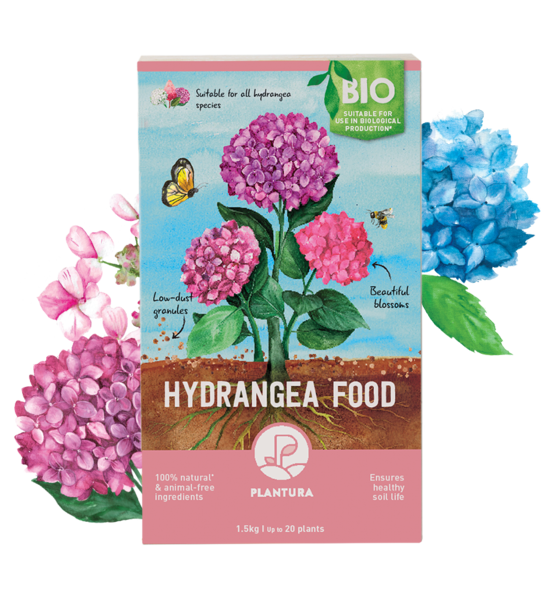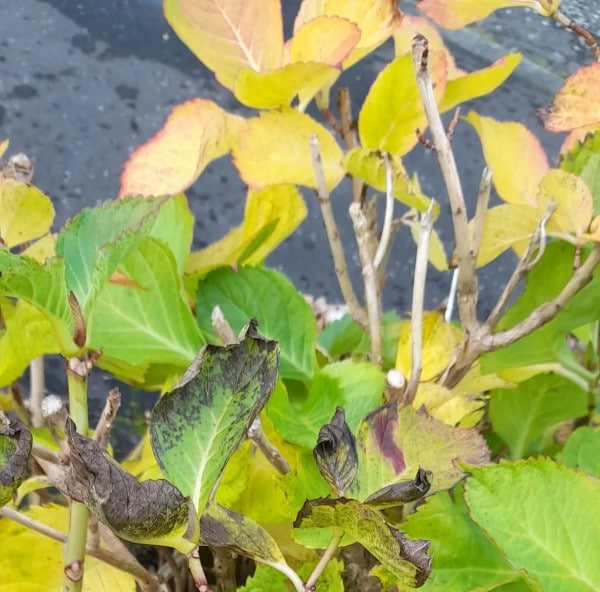Hydrangeas are popular flowering shrubs, but their leaves can sometimes turn yellow and ruin their beauty. As a hydrangea owner, yellow leaves are worrying, but there are solutions to get your plant back to its vibrant self. Let’s look at why hydrangea leaves turn yellow and what you can do to fix it.
What Causes Yellow Leaves on Hydrangeas
There are a few key reasons hydrangea leaves turn yellow:
Iron Deficiency
The most common cause of yellow hydrangea leaves is a lack of iron which the plant needs to produce chlorophyll and keep leaves green. This iron deficiency shows up in a distinct pattern – the leaf veins stay green while the tissue between them turns yellow.
Iron deficiency is usually tied to the soil conditions Overwatering leaches iron from the soil, Poor drainage or compacted soil prevents iron uptake, High pH soils above neutral contain iron that hydrangeas can’t access, Insufficient iron fertilization also leads to deficiency over time
Other Nutrient Deficiencies
While less common than iron, shortages of nitrogen, phosphorus, magnesium, manganese, zinc, and sulfur can also cause yellowing. Each deficiency has slightly different patterns on the leaves. General yellowing of older leaves often indicates low nitrogen. Yellow spots and striping point to manganese or zinc problems.
Root Damage
Root damage from digging, transplanting, or diseases like root rot limit the roots’ ability to take up nutrients. The damaged roots can’t provide enough iron and other elements to sustain leaf growth. As new leaves form, they lack chlorophyll and turn yellow.
Pests and Diseases
Pests like aphids, scale, and spider mites suck nutrients from the leaves, eventually turning them yellow. Fungal diseases also impair leaf function. If the whole shrub is declining, this may be the cause of yellowing.
Age
As a hydrangea matures and focuses energy on flowering, interior leaves that receive little light naturally turn yellow and drop. This is normal for older hydrangeas.
Weather Issues
Extreme conditions like drought, waterlogging, or frost damage can stress the roots. This reduces their nutrient uptake capacity. New growth turns yellow as a result.
How To Treat Yellow Hydrangea Leaves
The treatment depends on the underlying cause. Here are some tips:
- For iron deficiency chlorosis, apply a chelated iron supplement. This quickly greens leaves again. Going forward, adjust soil conditions to prevent recurrence.
- If overwatering, allow soil to dry out between waterings. Improve drainage with sand or gravel.
- For high pH soils, amend with sulfur or peat moss to lower pH. Use an acidic fertilizer made for hydrangeas.
- If underfertilizing, feed with a balanced fertilizer or one made specifically for hydrangeas. Follow package directions.
- Damaged roots need time to regrow. Avoid transplanting and dig around the base carefully.
- Apply insecticidal soap or other organic treatments for sap-sucking pests. Remove affected leaves.
- For fungal diseases, use fungicides suitable for the issue following label directions. Improve air circulation around plants.
- Interior yellowing on mature plants is natural. Simply remove dead leaves to improve appearance.
- For weather stress, allow soil to dry between waterings after flooding. Protect from frost and provide shade during heat waves.
Along with these treatments, always ensure hydrangeas have sufficient water and mulch. Give them a bit more TLC until the yellow leaves subside.
How To Prevent Yellow Hydrangea Leaves
While occasional yellowing is normal, follow these tips to avoid ongoing issues:
- Choose the right location with morning sun and afternoon shade. Hydrangeas thrive in zones 3-9.
- Prepare the soil well with compost and adjust pH to slightly acidic around 5.5. Hydrangeas love rich, moist, well-draining soil.
- Water 1-2 inches per week consistently, allowing soil to partially dry between waterings.
- Mulch around the base to retain moisture and even out soil temperatures. Leave space between mulch and stems.
- Feed every 2-3 weeks during the growing season with a balanced fertilizer. Use one formulated for hydrangeas if possible.
- Prune out dead wood and old flower heads each spring to encourage new growth.
- Monitor for common pests like aphids and diseases such as powdery mildew. Treat promptly if found.
- Protect plants from harsh weather extremes that can damage roots and growth.
- Test soil pH yearly and amend if needed to maintain the ideal acidity.
Following these best practices tailored to hydrangeas sets your plants up for success! Then you can enjoy their lush blooms without the annoyance of yellow leaves.
When To Worry About Yellow Hydrangea Leaves
While yellow leaves are normal here and there, be concerned if:
- Leaves turn yellow in high numbers
- You see no new green growth
- Leaf loss leads to thinning
- Stems die back
- Whole shrub declines
If your hydrangea shows these warning signs, yellow leaves likely indicate a major underlying problem. Iron deficiency is probably not the only issue present. Dig deeper to identify and correct what’s wrong before the hydrangea sustains permanent damage.
FAQs About Yellow Hydrangea Leaves
What does yellow hydrangea leaves mean?
Yellow hydrangea leaves are primarily caused by iron deficiency, though other nutrient shortages, root problems, pests, and diseases can also lead to chlorosis. Age and weather extremes contribute too. Identify the cause to treat yellow leaves properly.
How do I turn my yellow hydrangeas green again?
For iron deficiency, supplement with chelated iron. Improve soil conditions like drainage and pH to support better iron uptake long term. Fix root damage, treat pests and diseases, and moderate watering for other causes.
Should I cut off yellow hydrangea leaves?
Removing spent interior leaves on mature plants improves appearance. But don’t cut off yellow leaves on struggling plants, as they still photosynthesize. Treat the cause instead to green up new growth.
What nutrient deficiency causes yellow leaves?
Along with iron, low nitrogen, magnesium, manganese, zinc, and sulfur can cause yellowing. Each has slightly different leaf patterns based on mobility in the plant. Nitrogen deficiency starts on lower leaves, while immobile manganese shows up as yellow spots.
Do hydrangeas go through dormancy?
Hydrangeas do not fully go dormant but experience reduced growth in winter. Leaves may yellow or redden due to light exposure and colder temperatures. Pruning just spent flowers at this time encourages faster spring growth.
Bring Your Yellow Hydrangea Leaves Back to Life
It’s distressing to see your prized hydrangeas marred by yellowing leaves. But in most cases, it’s possible to nurse them back to health. Follow the tips above to diagnose the problem, treat yellowing correctly, and improve care to stop it recurring. With a little TLC, your hydrangea’s leaves will be lush and green again in no time!
You want to know who’s behind Plantura?


I studied agricultural sciences and have always preferred spending my free time outdoors. Besides being interested in farming and gardening, I love taking pictures and almost never leave the house without my camera. I can usually find a great picture that shows the beauty of nature, whether it’s a landscape, a flower, or a wild animal. Favourite fruit: strawberries, blueberries, plums Favourite vegetables: radishes, tomatoes, pumpkin.
It is very common for hydrangea leaves to turn yellow, which means the plant is lacking in nutrients. Read on to find out how to identify and remedy the issue.

The leaves of your hydrangea may turn yellow because they aren’t making enough chlorophyll because they don’t have enough iron. This is known as chlorosis. Iron is one of the most important parts of making chlorophyll, which is a key part of photosynthesis. Photosynthesis, as we all know, is essential for plant survival, so chlorosis needs to be treated quickly.
While chlorosis can be caused by other nutrient deficiencies, it is most commonly an iron deficiency. You will learn how to tell if your plant has an iron deficiency or something else in the next section. We also explain how to treat an iron deficiency and give advice on how to keep chlorosis from happening in the first place.
Tip: Iron deficiency is particularly common in hydrangeas and other bog plants that love acidic soils.
How to treat chlorosis in hydrangeas
The first step in remedying chlorosis is to check and adjust the pH of your soil. In very rare cases, however, there may be an “absolute” iron deficiency, where iron simply is not present. Because there isn’t much iron in potting compost, this happens more often with potted plants than with bedded plants. If the pH level of the soil is low and the hydrangea still shows the above signs of iron deficiency, you need to add iron to the soil. This can be done either with fertiliser granules, liquid fertiliser or foliar fertilisation:
- Granular fertilizer with iron: A specially designed granulated fertilizer works well to treat iron deficiency and can also help keep it from happening in the first place. For example, our Plantura Hydrangea Food has enough iron in it to completely rule out the risk of iron deficiency right from the start. This also stops a relative iron deficiency by making the soil slightly acidic with iron sulfate. Our Plantura Hydrogenarea Food is made from materials that don’t come from animals and minerals that are also used in organic farming.

- For lovely hydrangeas in pots with lots of blooms
- Prevents common deficiency symptoms & supports healthy plant growth
- Child-safe fertilizer that lasts a long time and doesn’t contain any animal products
- Compound fertilizer with iron: A good compound fertilizer with iron and “chelating agents” works faster and better than the granule method. At their roots, plants make chelates that change iron into a form that plants can use. Because hydrangeas can’t do this on their own, they need a special fertilizer. Our Plantura Liquid Citrus Food has iron, other trace elements, and the right chelating agents to quickly and effectively fix deficiencies.
- Foliar iron fertilization: Plants can also take in some nutrients through their leaves. In this way, the trace element gets to the parts of the plant that need it. However, iron foliar fertilisation is usually unnecessary for private users. It’s only used on a commercial level, where a long-term lack of iron would cause big losses in crop yield. Often, these special fertilizers are pricey and need to be used in very precise amounts so as not to hurt the leaves. Foliar fertilization only works for a short time, so it needs to be done often or along with regular iron fertilization.

Hydrangea Leaves Turning Yellow? You May Need to Do This!
- The Ultimate Guide to Growing Strawberries in Raised Beds - August 8, 2025
- No-Dig Garden Beds: The Easiest Way to Grow a Beautiful Garden - August 6, 2025
- How to Protect and Preserve Wood for Raised Garden Beds - August 6, 2025

